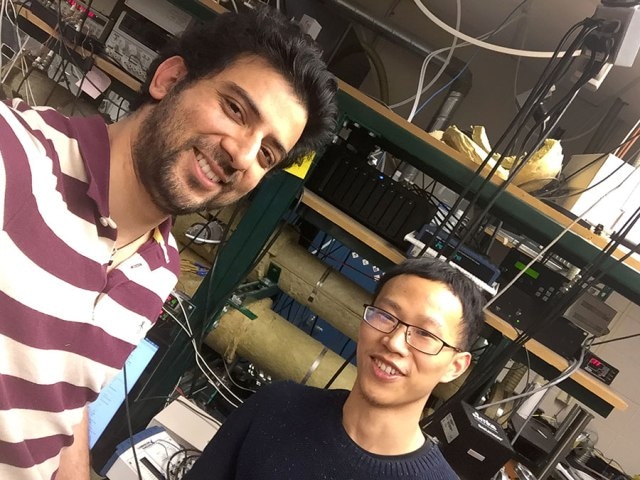Jun 20 2016
Scientists from the Texas Analog Center of Excellence (TxACE) at UT Dallas are involved in the development of a low-cost electronic nose to conduct breath analysis for various health diagnosis.
 Dr. Navneet Sharma (left) and Qian Zhong of UT Dallas are part of a research team working to create an affordable electronic nose that can improve breath analysis. Sharma is the lead author of a new study that reveals the benefits of using CMOS integrated circuits technology in the device.
Dr. Navneet Sharma (left) and Qian Zhong of UT Dallas are part of a research team working to create an affordable electronic nose that can improve breath analysis. Sharma is the lead author of a new study that reveals the benefits of using CMOS integrated circuits technology in the device.
Dr. Kenneth O, a principal investigator of the effort and director of TxACE, said that the currently available devices use compound semiconductors for breath analysis, but they are large and very expensive for commercial use.
According to investigators, the affordable electronic nose could be possible with the use of CMOS, an integrated circuits technology used to produce a large amount of electronics that are being used to make tablets, smartphones and other devices.
On Wednesday, the study paper titled “200-28 0GHz CMOS Transmitter for Rotational Spectroscopy and Demonstration in Gas Spectroscopy and Breath Analysis” was presented at the 2016 IEEE Symposia on VLSI Technology and Circuits in Honolulu, Hawaii.
Smell is one of the senses of humans and animals, and there have been many efforts to build an electronic nose. We have demonstrated that you can build an affordable electronic nose that can sense many different kinds of smells. When you’re smelling something, you are detecting chemical molecules in the air. Similarly, an electronic nose detects chemical compounds using rotational spectroscopy.
Dr. Navneet Sharma, UT Dallas
The rotational spectrometer produces and passes on electromagnetic waves through different frequencies, and evaluates how these waves are alleviated to decide the presence of chemicals and their intensity in a sample. The device can help to identify the levels of chemicals that exist in human breath.
Breaths have gases that come from the stomach and that emerge from the blood when it makes contact with air in the lungs. The breath analyzer is a type of blood test without using the blood samples. The breath has information regarding nearly all parts of a human body.
The new electronic nose is capable of identifying gas molecules with more sensitivity and specificity compared to Breathalyzers that can mistake acetone for ethanol in the breath. The excellence is vital, for instance, for Type 1 diabetic patients with elevated acetone concentrations in their breath.
If you think about the industry around sensors that emulate our senses, it’s huge. Imaging applications, hearing devices, touch sensors — what we are talking about here is developing a device that imitates another one of our sensing modalities and making it affordable and widely available. The possible use of the electronic nose is almost limitless. Think about how we use smell in our daily lives.
Dr. Kenneth O, Professor, UT Dallas
The scientists visualize that the CMOS-based system will be at first utilized in industrial settings and then later in hospitals and doctors’ offices. The technology, when it matures, could be developed into domestic devices. Dr. O said that the technology could minimize the need for gastrointestinal and blood tests, detect diseases earlier and lower health care costs.
The scientists are currently working together to develop a programmable electronic nose model that can be released sometime in early 2018 for beta testing.
Texas Instruments Inc. and the Semiconductor Research Corporation (SRC) have largely supported TxACE and this research, while Samsung Global Research Outreach provided additional support.
SRC and its members, including Texas Instruments, Intel, IBM, Freescale, Mentor Graphics, ARM and GlobalFoundries, have been following this work for several years. We are excited by the possibilities of the new technology and are working to rapidly explore its uses and applications. It is a significant milestone, but there is still much more research needed for this to reach its potential.
Dr. David Yeh, Senior Director, SRC
TxACE was formed in 2008 by the SRC, the state through its Texas Emerging Technology Fund, the UT System, UT Dallas and Texas Instruments. It is the biggest analog circuit design research center situated in an academic institution. The center concentrates on analog as well as mixed signal integrated circuits engineering to enhance public safety and security, improve medical care and assist the U.S. to turn into more energy independent.
The researchers include UT Dallas doctoral students Jing Zhang and Qian Zhong; Dr. Mark Lee, professor and head of physics; Dr. David Lary, associate professor of physics; Dr. Rashaunda Henderson, associate professor of electrical engineering; Dr. Wooyeol Choi, assistant research professor; and Dr. Hyun-Joo Nam, assistant professor of bioengineering. Other members include Dr. Philip Raskin of UT Southwestern; Dr. C.F. Neese, Dr. Frank C. De Lucia and Dr. J.P. McMillan of Ohio State University; and Dr. Ivan R. Medvedev and R. Schueler of Wright State University.